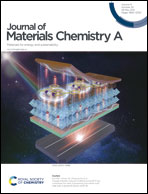Single atom catalysts supported on N-doped graphene toward fast kinetics in Li–S batteries: a theoretical study†
Abstract
To suppress the shuttle effect of lithium polysulfides and promote fast kinetics of the charge–discharge process in Li–S batteries, it is essential to search for promising catalysts with sufficient stability and high activity. Here, we employ density functional theory to explore the performance of 3d, 4d and 5d transition metals embedded in nitrogen-doped defective graphene (M@N/G, including M@N3/G and M@N4/G) as single atom catalysts toward fast kinetics in Li–S batteries. Four evaluation criteria of M@N/G are established to guide the screening of catalysts. Electronic structure analysis shows that the nitrogen coordination environment can largely tune the valence orbital splitting of the metal center and further affect the intrinsic activity of catalysts; M@N4/G exhibits superior catalytic performance to M@N3/G. We also found that sulfur–metal interactions play a critical role in the adsorption and activation of sulfur species on M@N/G. We therefore propose to use the sulfur atom adsorption free energy as a descriptor of catalytic activity combined with the knowledge of M3d@N/G to effectively predict the activity of M4d,5d@N/G. As a result, we expect that the Sc, Cr, Mn, Ru, Os, and Ir single metal atom catalysts supported on N4/G have better than or at least comparable catalytic performance to the ever-reported V, Fe, and Co@N4/G for Li–S batteries. In particular, because of the low cost, Cr@N4/G and Mn@N4/G are preferentially recommended with a small free energy change of the rate-determining step (0.62 eV and 0.54 eV) during discharge and a low decomposition barrier of *Li2S (1.42 eV and 1.29 eV) during charge simultaneously. Our study builds a novel screening strategy and can guide future theoretical study on catalysts toward Li–S batteries with fast kinetics.



 Please wait while we load your content...
Please wait while we load your content...